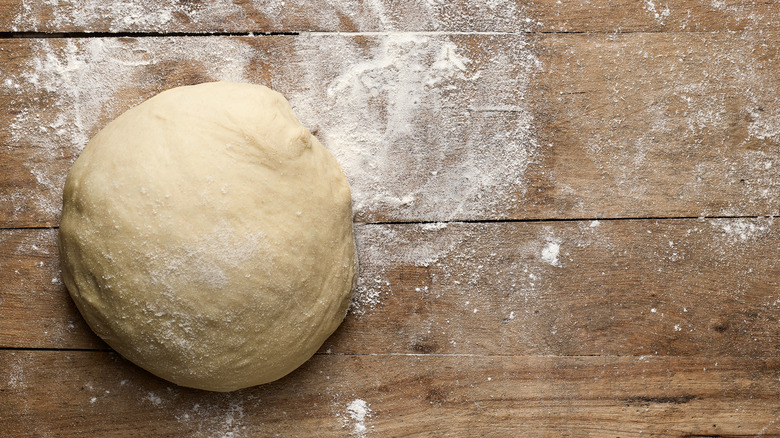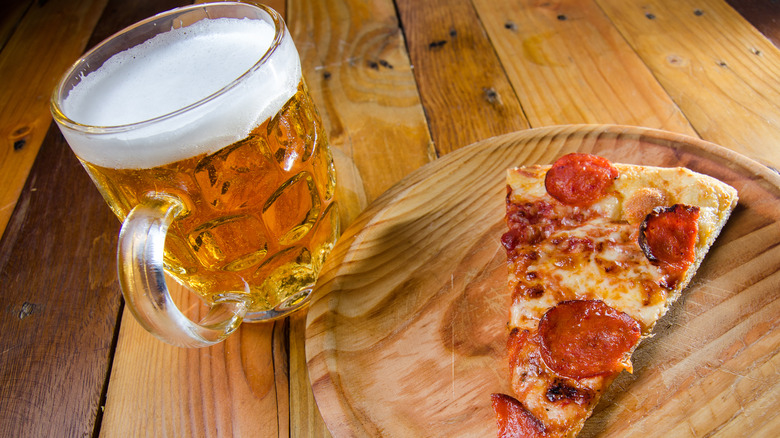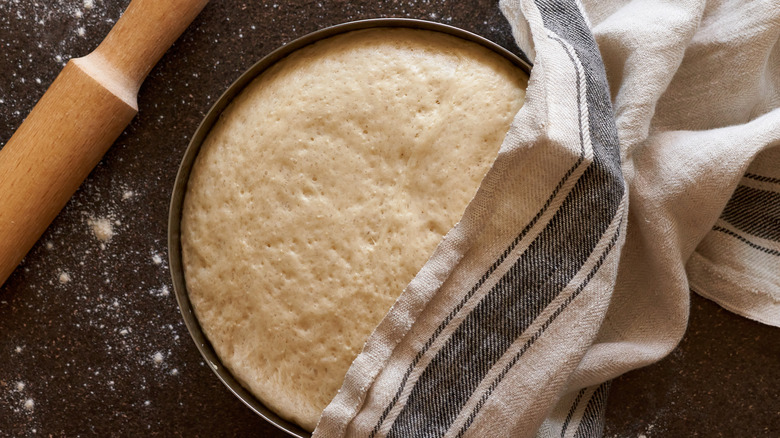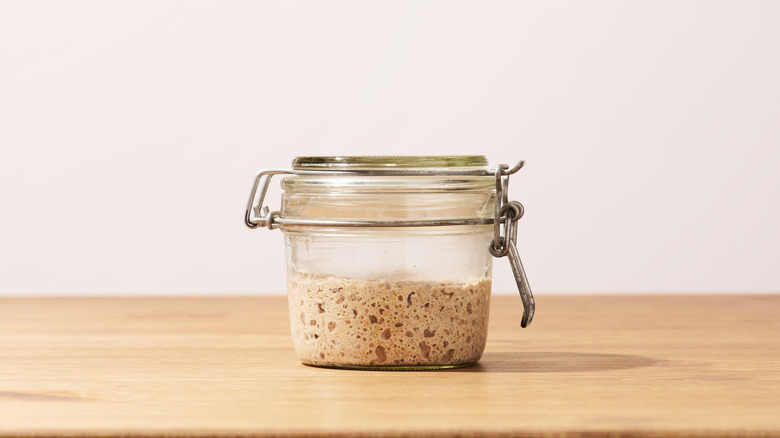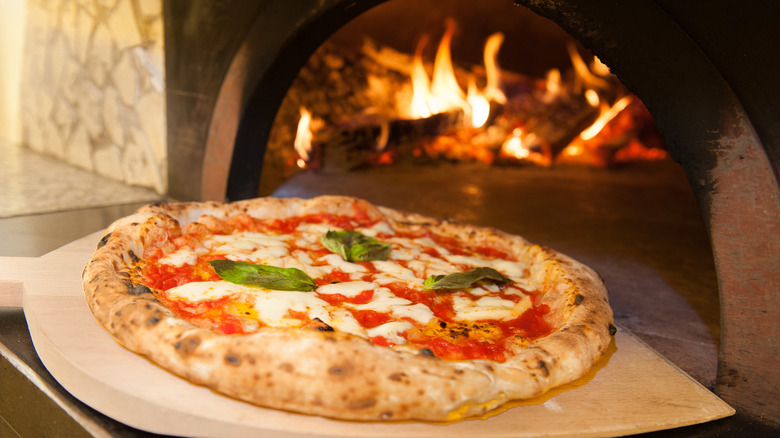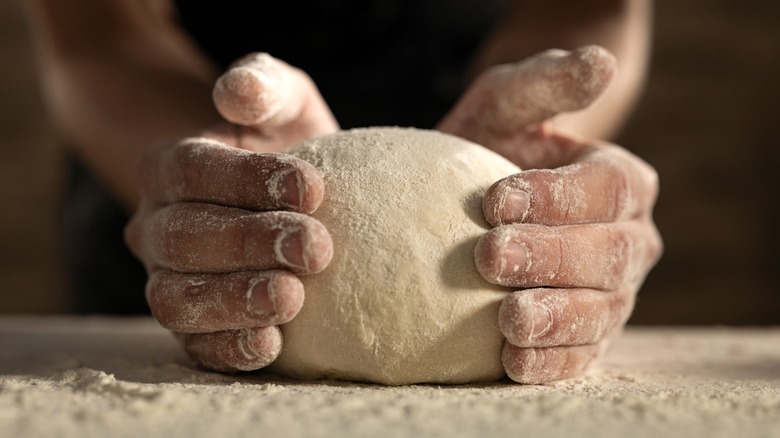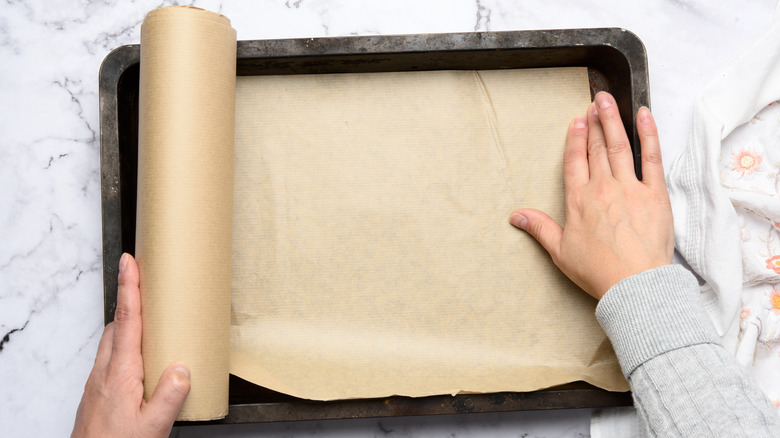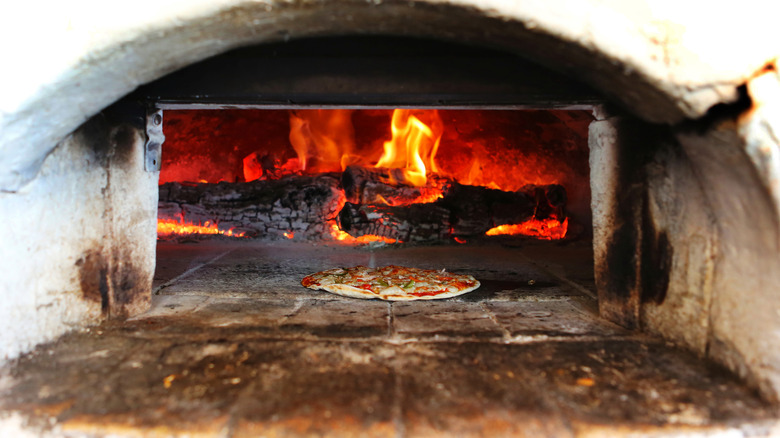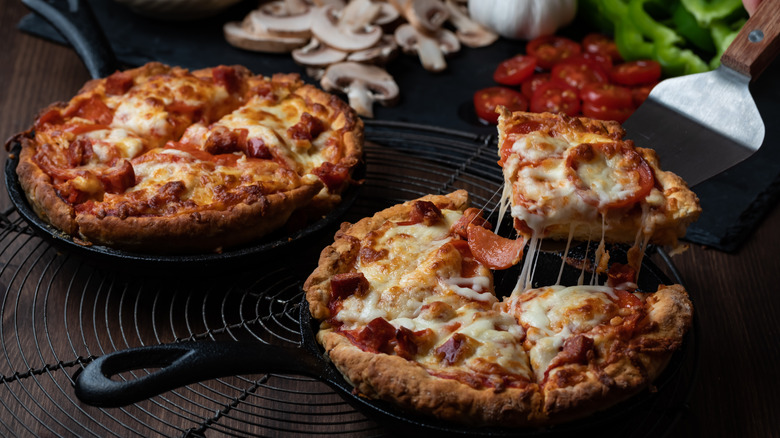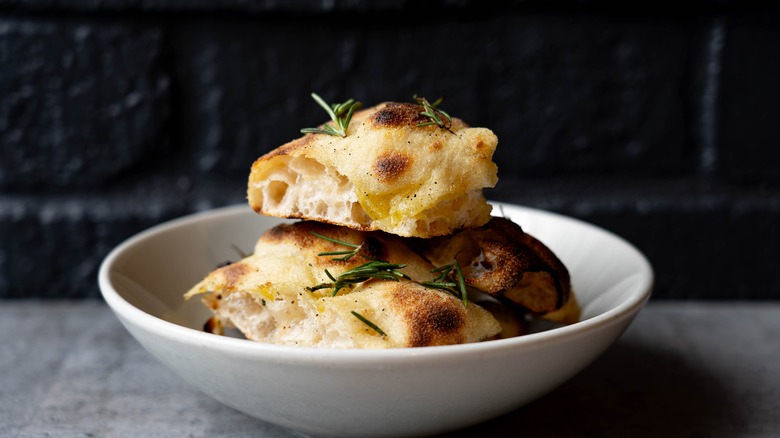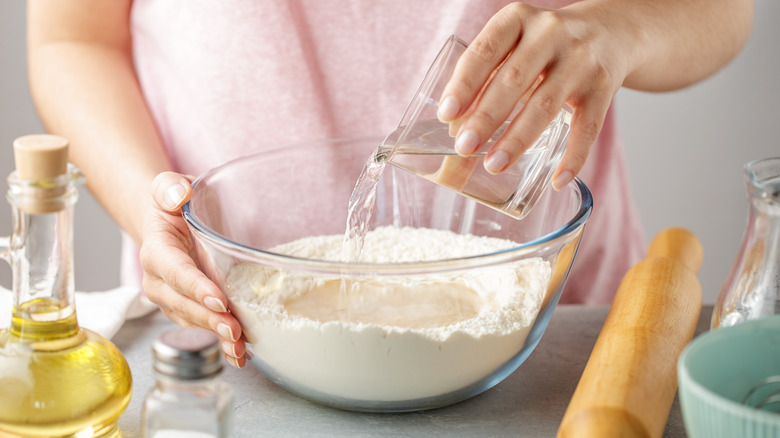10 Tips You Need When Making Homemade Pizza Crust
In most cases, pizza is so easy and cheap to buy from a restaurant that it hardly seems worth the effort to make at home — until you discover just how easy it is to recreate. Making your own pizza dough gives you full control of the recipe and ingredients so that the final pizza can be tailored completely to your liking. Pizza dough, like many bread doughs, is light on the number of ingredients but heavy on the technique.
Just some flour, water, yeast, and salt can create a crispy, chewy pizza dough, but the devil is in the details, and a few small mistakes can ruin the final product. Read on for our best tips for nailing homemade pizza dough with a little help from a few expert bakers, Martin Philip, head baker at King Arthur Baking Co., and Veronica Mclean, a chef at Roberta's Pizza in Los Angeles.
Use beer
Pizza and beer are a culinary match made in heaven. There's nothing quite like a crispy, hot slice of cheesy pizza paired with a crisp, ice-cold beer. Beyond a food and beverage pairing, there's another way to capture this amazing flavor combination. Beer can also be used as an ingredient that will change your pizza dough forever. The carbonation in the beer provides a natural leavening, while the yeast and fermentation add a boost of flavor. Some recipes utilize beer as a replacement for yeast, while others use it with instant or fresh yeast. This technique can be especially handy if you make pizza dough and find yourself fresh out of yeast.
The best kind of beer for pizza dough is a lighter brew like a pilsner or lager. For a stronger flavor, try experimenting with a heady IPA. No matter what kind of beer you use, make sure it is at room temperature before adding it to the pizza dough.
Let the dough rest
If you have ever worked with dough before, you may have heard that it needs to rest. But what exactly does this mean, and why is it so crucial? Doughs made from wheat contain both gluten and gliadin, protein chains that allow the bread to be airy without collapsing in on itself. These proteins need to rest to stretch and relax, which can contribute to more volume and tenderness in the finished product.
When working with pizza dough, particularly recipes that call for a lot of kneading, the resting stage helps the dough relax enough so it can be stretched into a pizza shape. Anyone who has ever struggled to roll out pizza dough only to have it tighten back up into a thick disc has experienced the frustrations that come from skipping on resting time. Another symptom of inadequate resting is dough that is so tight it tears without stretching at all.
Use fresh yeast (or a well-fed starter)
Unless you are making crisp, flatbread pizza, your goal when making pizza dough should be a chewy, spongy crust that is full of yeasty flavor. In order to achieve this, you will need to make sure all the ingredients are just right. That means flour that isn't expired, water that is the right temperature, and fresh yeast. Old, expired yeast can lead to tragic consequences, like dough that fails to rise. Fresh yeast, as opposed to instant, may be worth sourcing for this baking project as it comes with a slightly deeper flavor.
The absolute best pizza doughs use sourdough starters instead of yeast to achieve the best possible flavor. While still providing the rise and leavening of commercial yeast, sourdough starter harnesses the power of wild yeast and combines it with the flavor of fermentation to create that classic sourdough tang we all know and love.
Make sure your oven is hot, and we mean HOT
Traditional Neapolitan-style pizzas are made in a wood-fired oven. These ovens can reach temperatures in the thousands, and pizzas baked in them require a very short cooking time. This quick-but-hot cooking prevents the pizza dough from becoming too dry, which can easily happen when pizza is baked at lower temperatures (and is probably the reason your home pizza crust is too hard).
To recreate this environment in a home oven, you'll want to turn your oven as hot as it goes. For most non-commercial ovens, this will likely be about 500-550 F. If you have a pizza or baking stone, use it! Just make sure to put it in before you start preheating your oven so it can get nice and hot. This high heat may set your smoke alarms off due to some oven residue burning off, so crack a couple of windows.
Nail the hydration
Even though adding water to dough can seem like a recipe for a soggy crust, using the proper amount of liquid is an essential part of making pizza dough with a perfectly crisp crust. The ratio of water to flour (often called "hydration") has to be in perfect harmony to achieve the right crust texture. Water turns into steam during the baking process, which contributes to leavening and helps the gluten strands soften so large air bubbles can form.
Getting the hydration right is one of the most common pitfalls of home pizza dough creation, as it relies on skill and experience to get it right. Since hydration will vary depending on the climate of wherever you are baking and the specific ingredients used, all pizza dough recipes will not work perfectly in all situations. A good way to begin is to start with 65% hydration (meaning the amount of water is 65% of the amount of flour used). The dough should be as sticky as it can be while still being workable.
Use parchment to slide the dough into the oven
Once the dough is made and the toppings placed, a common conundrum arises. How does one transfer the pizza to the oven? Professionals use a pizza peel, that sheet of metal attached to a long handle you've undoubtedly seen pizza chefs use to slide pizzas in and out of the oven. Yes, you can always buy one, but this kitchen tool can be bulky to store.
Without a pizza peel, the best way to get the pizza into the oven is to stretch the dough onto a sheet of parchment paper before topping. Once the toppings are loaded up, slide the whole thing onto an upside-down baking sheet, then walk over to the oven and slide the whole thing onto your preheated baking stone or another baking surface. Another benefit of using parchment paper is that the dough will stick to the paper and become less likely to contract. Once the pizza is baked, the dough will release easily from the paper.
Get a baking stone
Even if you can replicate a great restaurant pizza dough at home, there will still be one major factor that separates the home baker from the professional chef. Commercial pizza ovens have brick bottoms that become superheated before the pizza ever enters the window. This hot brick surface bakes the pizza from the bottom up and ensures a crispy (not soggy) texture.
If you aren't one of the lucky few who have an in-home brick pizza oven, fear not. This technique can be replicated at home with the assistance of a pizza or baking stone. These stone surfaces are roughly the size and shape of a sheet tray (some are round like a pizza) and designed to withstand temperatures exceeding 500 F. Place one in your oven before preheating, and it will provide the perfect surface to bake pizza on. An upside-down baking sheet in a pinch can also work, though not entirely.
Try it in a cast iron skillet
If transferring the pizza to the oven is still too intimidating, consider making a cast iron skillet pizza. Cast iron skillet pies are like Chicago deep-dish style and feature a thick bottom. A cast iron skillet is great at transferring heat, so there is no need to worry about a soggy bottom.
Stickage can be an issue, but there are a few ways to prevent pizza from sticking to a cast iron skillet. Using a blend of flour and cornmeal on the pan before adding the dough can help the pizza release from the pan when done cooking. According to Martin Philip, head baker at King Arthur Baking Co., "cornmeal keeps the dough from sticking and, once toasted, adds a nutty speckled crunch to the bottom crust." For a similarly crispy texture without the cornmeal, coating the pan in a generous amount of olive oil could be the answer. Not only will the oil prevent the dough from sticking to the pan, but it also transfers heat and can help create a deliciously crispy crust.
Try a focaccia recipe for dough
Focaccia recipes are notoriously simple to make and rarely call for any real kneading beyond the initial mixing of ingredients. Luckily for intrepid pizza bakers, focaccia works famously well as a pizza dough. The finished product won't be like some Neapolitan-style pizzas or even thin-crust pies, but more like thick, sheet-pan style pizzas. This style of pizza is sometimes called "grandma" style, as it is a favorite method amongst Italian grandmothers and is easy to make at home.
In order to make this switch work for you, prepare your favorite focaccia recipe and stretch it into a sheet tray coated with oil. Pockmark the top just as you would with plain focaccia, then add cheese, sauce, or toppings to your heart's content. Keep in mind that focaccia dough can rise as much as two inches in the oven, so if you need to split the recipe between two trays to avoid an overly bready pizza, then feel free to do so.
Make sure the water temperature is right
Even the smallest details matter in a recipe with as few ingredients as pizza dough. According to Veronica Mclean, a chef at Roberta's Pizza in Los Angeles, "water temp is crucial and fluctuates depending on the time of year, the climate you live in, and even the elevation in which you live in." While the exact temperature can vary from recipe to recipe, typically, the ideal water temperature for pizza dough is between 110 and 115 F. If using instant yeast, most packages recommend a water temperature somewhere between 120 and 130 F.
When it comes to sourdough starter, Mclean says, "in summer we will add ice to the water to make it cool enough to work with so that it doesn't ferment too quickly. In winter, we have to leave the starter out longer to ferment. It's a constant re-evaluation of what conditions you are making and baking the dough in. If you are going to use a natural leavened dough recipe, do yourself a favor and research and get acquainted with fermentation."
